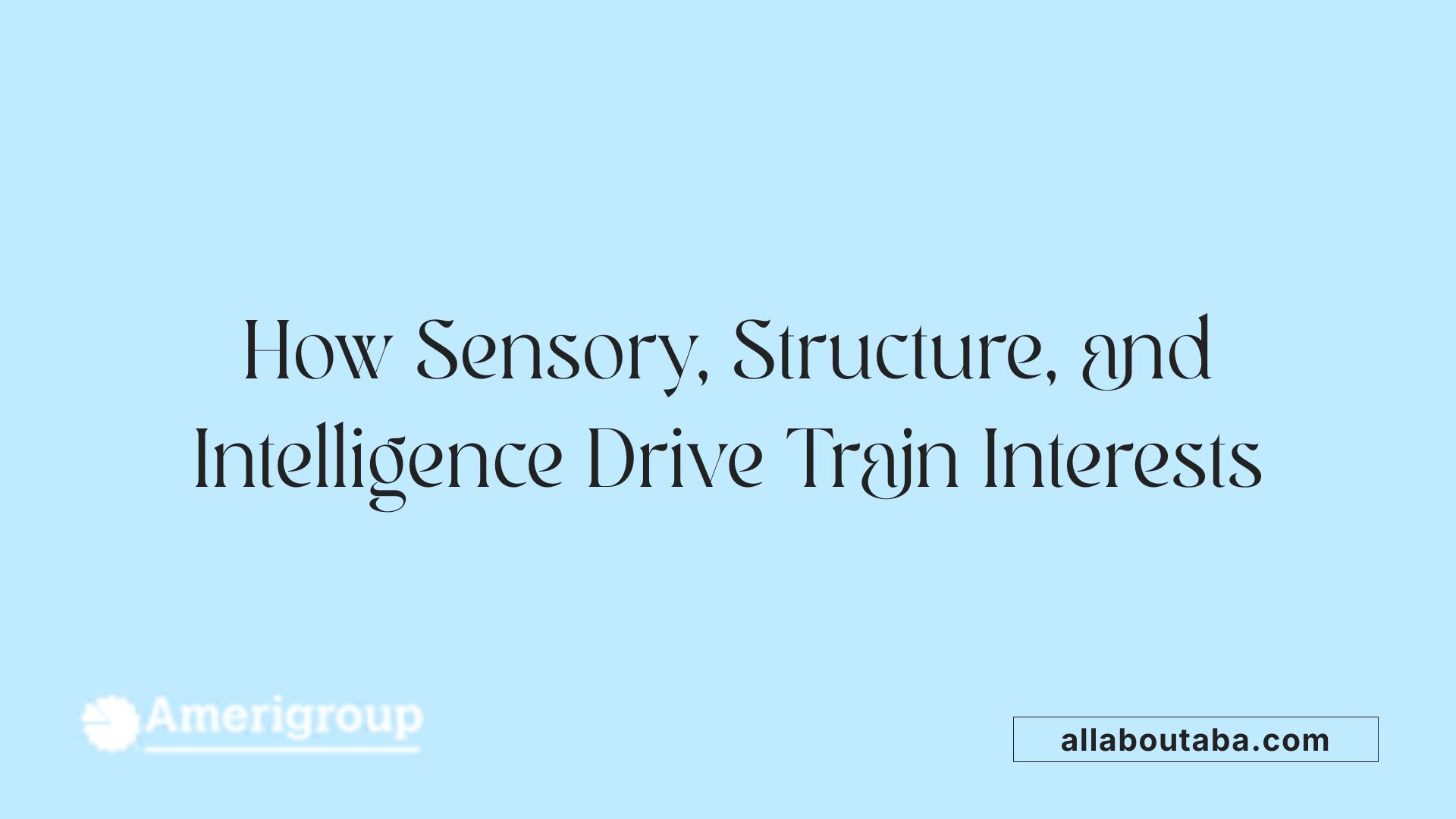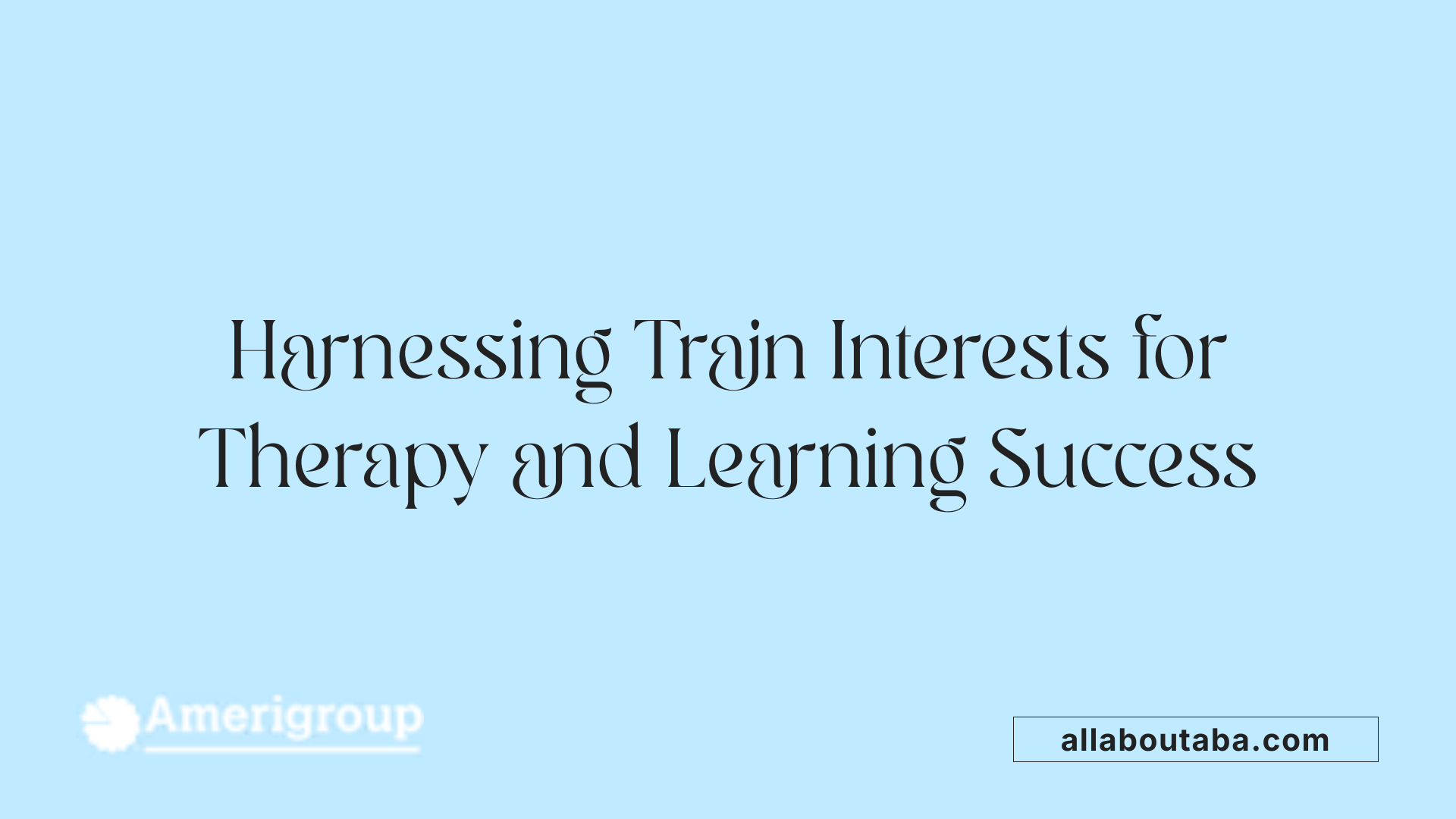Understanding the Deep-Rooted Appeal of Trains Among Autistic Individuals
Many individuals on the autism spectrum develop a pronounced interest in trains, finding them engaging, comforting, and intellectually stimulating. This fascination is rooted in the unique ways trains align with their sensory preferences, need for routine, and analytical strengths. Exploring these connections can offer insight into how interests like trains serve not only as sources of joy but also as tools for development and well-being.
The Psychological and Sensory Foundations of Train Interests

Why are train interests common among autistic individuals?
Many children and adults on the autism spectrum develop a fascination with trains, and there are several reasons why this interest is so prevalent.
Firstly, trains appeal strongly to the sensory preferences often observed in autistic individuals. The rhythmic sounds of trains, including the chugging of engines and the clatter of wheels on tracks, can be calming and mesmerizing. Visual patterns, like the neat arrangement and repetitive motion of train cars, add to their sensory appeal. These sensory inputs can help regulate emotions and provide comfort, making train-related activities soothing.
Secondly, the structured and predictable nature of trains aligns well with the preference for routine commonly seen in autism. Trains operate on set schedules, follow fixed routes, and involve clear, well-understood systems. For many autistic individuals, this predictability reduces anxiety and offers a sense of control. The consistency of train travel and the orderly organization of train cars or models provide a familiar and secure environment.
Third, trains stimulate organizational and cognitive interests. The complexity of train systems—including types of trains, schedules, routes, and the mechanical details of engines—can engage those who enjoy categorizing and understanding systems. This interest in classification and organization helps develop focus, problem-solving skills, and a sense of mastery. Many enjoy collecting model trains or memorizing schedules, which further enhances their engagement and provides a rewarding challenge.
Experts like Dr. Temple Grandin emphasize that the rhythmic motion of trains and the visual patterns they create can foster a calming effect, helping individuals manage sensory sensitivities and stress. Moreover, train activities can serve as a bridge for social bonding and communication. Joining train clubs, watching trains in operation, or sharing train-related interests with family and friends foster social interaction and confidence.
In summary, train interests combine sensory stimulation, structural predictability, and intellectual engagement, making them particularly attractive and beneficial for many on the autism spectrum. These interests not only provide comfort but also serve as powerful tools for learning, therapy, and personal growth.
| Aspect | Description | Additional Details |
|---|---|---|
| Sensory Appeal | Rhythmic sounds, visual patterns, motion | Calming and stimulating sensory input |
| Organization | Categorization of train types, schedules | Engages logical and system-oriented minds |
| Routine & Predictability | Fixed schedules, consistent routes | Reduces anxiety and increases comfort |
| Educational & Social | Model trains, train clubs, watching activities | Enhances learning, communication, social skills |
This multifaceted interest in trains offers a tangible way for autistic individuals to feel secure, engaged, and validated, fostering both personal development and well-being.
How Predictability and Sensory Stimulation Deepen the Fascination
 Autistic individuals often find trains particularly captivating due to their inherent predictability and sensory appeal. The structured schedules, fixed routes, and repetitive operations of trains provide a consistent routine that offers reassurance and a sense of control. This predictability helps reduce anxiety by creating an environment that feels safe and familiar, which is especially comforting in an otherwise unpredictable world.
Autistic individuals often find trains particularly captivating due to their inherent predictability and sensory appeal. The structured schedules, fixed routes, and repetitive operations of trains provide a consistent routine that offers reassurance and a sense of control. This predictability helps reduce anxiety by creating an environment that feels safe and familiar, which is especially comforting in an otherwise unpredictable world.
The sensory elements of trains also play a significant role in their appeal. Trains produce rhythmic sounds like chugging and whistle noises that many find calming or mesmerizing. The visual patterns of moving train cars, glowing signals, and rotating wheels offer stimulating visuals. Additionally, vibrations and tactile feedback from the wagons and tracks can satisfy sensory needs, either calming or stimulating individuals depending on their preferences.
Together, these features foster a sense of order and mastery. Many autistic individuals enjoy memorizing schedules, engine types, or historical facts about trains, further reinforcing their engagement. The combination of routine, sensory input, and the fascination with intricate systems aligns with autistic tendencies for focus, organization, and exploration.
This deep interest can support emotional regulation by providing predictability and sensory comfort. It also creates opportunities for social connection, whether through shared train-watching activities or model train clubs. Moreover, incorporating train-related activities in therapy or education can enhance learning and motor skills.
In summary, the blend of these predictable and sensory elements forms the foundation of a compelling fascination that offers both comfort and stimulation. The enduring interest in trains exemplifies how routines and sensory experiences can support well-being, personal development, and a sense of mastery for autistic individuals.
The Use of Train Interests in Therapy and Education

How are train-based activities used in therapeutic settings?
In therapy, engaging with train activities can be highly effective for children on the autism spectrum. Therapeutic interventions often incorporate train-related play to promote motor skills, emotional regulation, and communication. For example, using model trains or train sets can help improve fine motor skills as children manipulate small parts or arrange tracks. Rhythmic sounds and repetitive movements associated with trains can also have a calming effect, reducing anxiety and helping children develop self-regulation skills.
Beyond individual therapy, train-themed activities foster social connections. Participating in train-watching outings or train club meetings provides structured group interactions, encouraging social skills and confidence. Therapists believe that these activities harness children’s natural fascination with trains to turn therapy into a positive and engaging experience.
How can trains be used in educational settings?
Trains serve as a versatile educational tool across various subjects. Their complex systems—comprising engines, tracks, signals, and schedules—offer excellent opportunities for teaching systems thinking and problem-solving. Educators use model trains to introduce concepts in math, such as counting, addition, and subtraction through schedule planning and car management.
In history and geography lessons, trains help illustrate technological progress, industrial development, and travel routes. Visual and hands-on activities, such as building model train habitats, enhance spatial awareness and coordination. Teachers can also use train schedules and data to develop organizational and time-management skills.
How does leveraging train interests facilitate social and communicative development?
Sharing an interest in trains opens avenues for meaningful social interactions. Enthusiasts often join train clubs or participate in train-watching events, creating social spaces where autistic individuals can connect with peers over a common passion. These shared interests promote language development, conversational skills, and the ability to share knowledge.
Train interests can also serve as motivating tools for learning new skills. For example, a child committed to train models might be encouraged to communicate more during collaborative activities or to practice following routines through train schedules. By integrating a strong hobby into learning and social contexts, educators and therapists help build confidence, reduce social anxiety, and foster a sense of achievement.
| Application Area | Method | Benefits |
|---|---|---|
| Therapeutic | Sensory integration activities with train sounds and visuals | Calming effects, emotional regulation |
| Educational | Building train models to teach math & spatial skills | Cognitive development, problem-solving |
| Social Skills | Joining train clubs & watch events | Social bonding, communication |
| Motivation & Engagement | Using train interests in therapy & learning | Increased focus, confidence |
Social and Cultural Dimensions of the Train Fascination

Participation in Model Train Clubs and Train-Watching Activities
Many children and adults on the autism spectrum find joy and community in participating in model train clubs and engaging in train-watching activities. These hobbies allow individuals to indulge their fascination with trains in structured social settings. Model train clubs often involve organized events where enthusiasts share their collections, build detailed scenery, and discuss various train types and systems, aligning with autistic interests in order, detail, and mechanics.
Train-watching, also called railfanning, involves observing trains at stations or along tracks. This activity can be calming and fulfilling, offering a predictable routine and a chance to focus on intricate details like train models, schedules, and movements. Such activities promote social interaction and can improve communication skills while providing a sense of belonging.
Cultural and Historical Significance of Trains and Their Stories
Trains are deeply embedded in history and culture, symbolizing travel, progress, and adventure. They evoke nostalgia for the industrial age and technological innovation. Many autistic individuals are drawn to the stories behind trains, including the historical development of railroads, famous routes, and pioneering engineers.
Understanding these stories offers another layer of interest through learning about historic events, cultural impacts, and technological advancements. Engaging with the history of trains helps meet educational goals while satisfying a preference for facts, order, and continuity.
Themed Media like "Thomas the Tank Engine" and "Sonic the Hedgehog"
Autistic individuals often enjoy themed media centered around trains and speed-themed characters. Shows like "Thomas the Tank Engine" or "Chuggington" and video games like "Sonic the Hedgehog" appeal because they feature predictable narratives, distinct characters, and consistent routines. These media formats provide comfort through familiarity, visual patterns, and repetitive themes.
Many find joy in the clear character traits and simple storylines, which facilitate comprehension and emotional connection. These media also serve as tools for social interaction, as children can talk about their favorite characters, episodes, or game scenarios, reinforcing language skills and social bonds.
Why Do Some Autistic Individuals Enjoy Themed Media Like "Thomas the Tank Engine" or "Sonic the Hedgehog"?
Many autistic individuals enjoy themed media like "Thomas the Tank Engine" or "Sonic the Hedgehog" because these media offer predictable stories, clear characters, and routine elements that provide comfort and reduce anxiety. Additionally, these media often align with their special interests, which are intense passions that foster a sense of expertise, identity, and happiness.
Engaging with familiar and visually stimulating content can help meet sensory processing preferences and provide calming effects. The strong focus on specific themes or characters allows autistic individuals to deepen their understanding and connection, boosting self-esteem and social engagement. Overall, these media sources serve as meaningful and satisfying outlets that support emotional well-being and personal interests.
Understanding the Distinction: Interests Versus Indicators of Autism
Many children and adults on the autism spectrum develop intense interests in specific topics, with trains being a common favorite. However, liking trains is not, by itself, an indicator of autism, as many neurotypical individuals also find trains fascinating. The distinguishing factor for autistic individuals is often the depth and focus of their interest.
For many on the spectrum, trains represent more than just a hobby. They often serve as a form of comfort and stability, given their structured nature, predictable schedules, and mechanical complexity. Trains appeal through sensory inputs such as rhythmic sounds, visual patterns, and vibrations, which can be calming and engaging.
Deep interests, like those in trains, are sometimes called "special interests" in autism diagnosis and support contexts. These interests can help with learning, social interaction, and emotional regulation. For example, children might use train-themed activities in therapy to improve motor skills or communication.
In diagnostic settings, a strong interest in trains might be observed alongside other behaviors typical of autism, like challenges with social communication or sensory sensitivities. Nonetheless, having an interest in trains alone does not diagnose autism. It is the intensity and function of these interests that are significant.
In summary, while an avid passion for trains is common among autistic individuals, it is not a standalone sign of autism. Instead, these interests can serve as strengths, helping to build skills and foster connection. Recognizing the difference between a normal hobby and a deep, focused interest is vital for understanding autism, emphasizing that such passions are valuable aspects of personal identity and development.
For more insights into how train interests relate to autism, searching "train interest and autism connection" can provide helpful resources.
Conclusion: Embracing the Strengths and Passions of Autistic Individuals
Supporting and embracing train interests in autistic individuals holds significant value for their development and well-being. These passions provide a foundation of routine and familiarity, which helps reduce anxiety and foster a sense of security. The predictable schedules, organized systems, and rhythmic sounds associated with trains align with the tendencies of autistic individuals to seek order and consistency, offering comfort in an otherwise unpredictable world.
Engaging with trains—whether through watching, collecting model trains, or participating in train-related activities—serves as a calming sensory experience. The visual patterns, spinning wheels, and repetitive sounds can soothe, stimulate, or mesmerize, supporting emotional regulation and focus. In addition, train interests often deepen cognitive skills, encouraging the exploration of history, geography, mechanics, and systems thinking.
Beyond personal growth, train passions can create opportunities for social interaction and communication. Participating in train clubs, train-watching outings, or shared hobbies enables autistic individuals to connect with others, build friendships, and develop social confidence. These shared interests can also serve as a bridge for learning new skills and improving communication.
Moreover, nurturing a fascination with trains can open pathways to educational and career opportunities. Fields such as transportation, engineering, logistics, and related sciences align with interests in mechanical systems and infrastructure. Supporting these passions can help autistic individuals envision future careers, fostering independence and a sense of purpose.
In summary, recognizing and supporting train interests not only enhances emotional stability and learning but also strengthens social bonds and opens professional avenues. Embracing these passions allows autistic individuals to thrive, leverage their strengths, and develop their full potential.
Celebrating Passions and Building Strengths
Recognizing and supporting the fascination with trains among autistic individuals not only affirms their interests but also opens avenues for growth, learning, and connection. These deep-seated passions serve as powerful tools for developing skills, reducing anxiety, and fostering self-confidence. Embracing such interests can lead to meaningful social interactions, educational achievements, and even future career paths in fields related to transportation, engineering, and technology. Ultimately, understanding why autistic people like trains highlights the importance of celebrating neurodiversity and the unique strengths each person brings.
References
- What is it about autism and trains?! - Autism Speaks
- Why Do Autistic People Like Trains? Understanding Special Interests
- Why Do Autistic People Like Trains?
- The Science Behind Why Many Autistic People Are Drawn to Trains
- Why Do Autistic People Like Trains? Understanding Special Interests
- What is it about autism and trains?! - Autism Speaks
- My Son's Train Obsession - A Parent Perspective on Sensory ...







